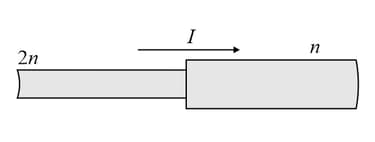Drift of Electrons and the Origin of Resistivity
Important Questions on Drift of Electrons and the Origin of Resistivity
Which of the following relations between the drift velocity and electric field obeys ohm's law.
Two cylindrical rods of uniform cross-section area and having free electrons per unit volume and respectively, are joined in series. A current flows through them in steady-state. Then, the ratio of drift velocity of free electrons in the left rod to drift velocity of electrons in the right rod is,

The drift velocity of electrons in a conducting wire is of the order of . Yet the bulb glows very quickly after the switch is put on because
Drift speed of electrons, when current flows in a copper wire of cross section is If the electron density in copper is the value of in is close to (Take charge of an electron to be )
A current is flowing through the wire of diameter having drift velocity of electrons in it. What will be new drift velocity when diameter of wire is made
When the temperature of a conductor increase the ratio of conductivity and resistivity ______.
The area of cross-section of a current carrying conductor is and at section and respectively. If and be the drift velocity at sections and respectively, then

Drift velocity, , varies with the intensity of electric field as per the relation,
A constant current source is connected to a wire. If the wire is stretched to twice its length, then the drift velocity:
Two wires of the same material but of different diameters carry the same current . If ratio of their diameters is , then the corresponding ratio of their mean drift velocities will be,
A metallic resistor is connected across a battery. If the number of collisions of the free electrons with the lattice is some how decreased in the resistor (for example by cooling it), the current will,
There is a current of in a copper wire whose area of cross-section is . If the number of free electrons per is , then find the drift velocity,
A potential difference of is applied at the ends of a copper wire of length and diameter . On doubling only , the drift velocity,
The drift velocity of the electrons in a copper wire of length under the application of a potential difference of is . Their mobility (in) is
If the free electron density be and relaxation time be , the electrical conductivity of a conductor may be expressed as

